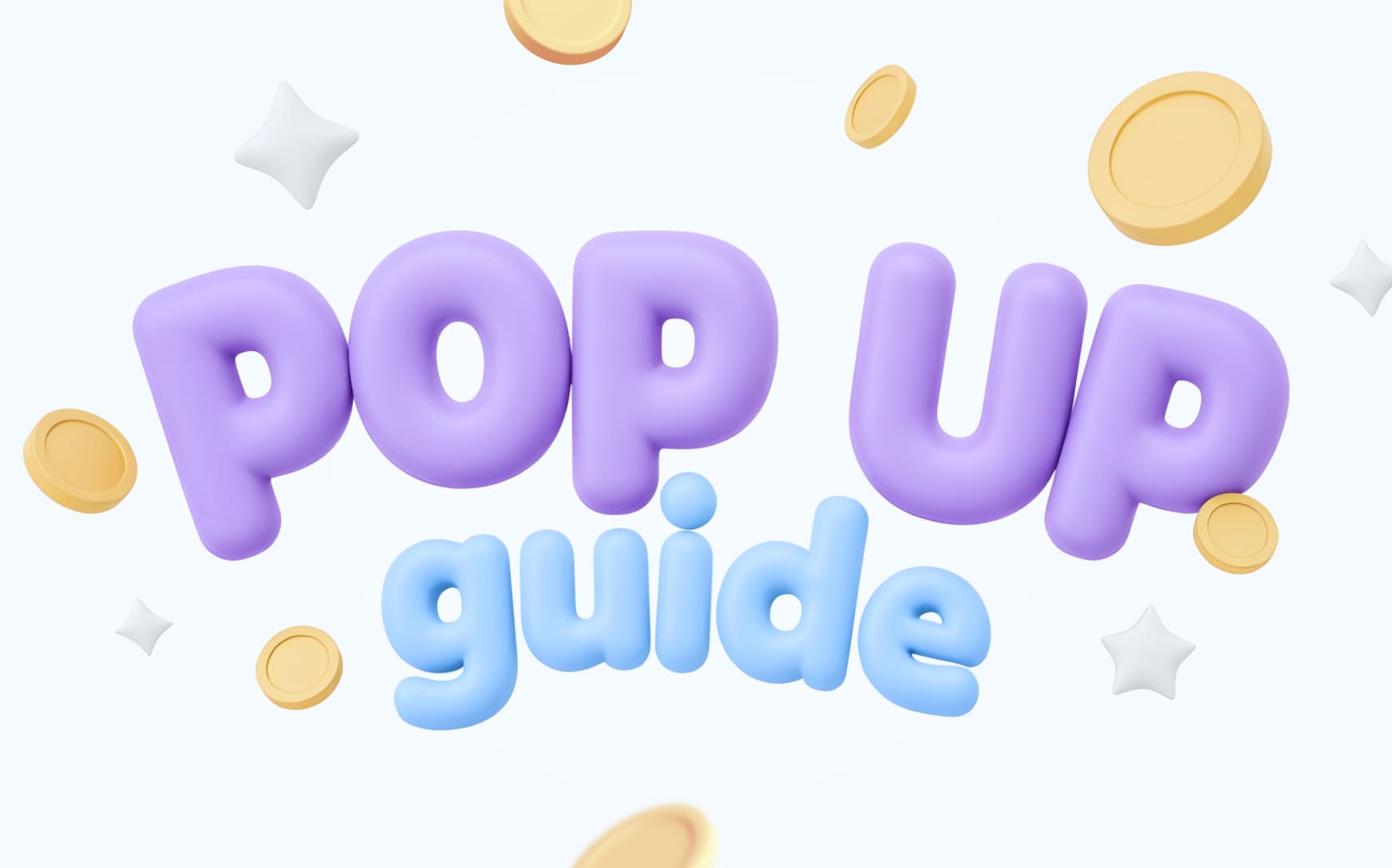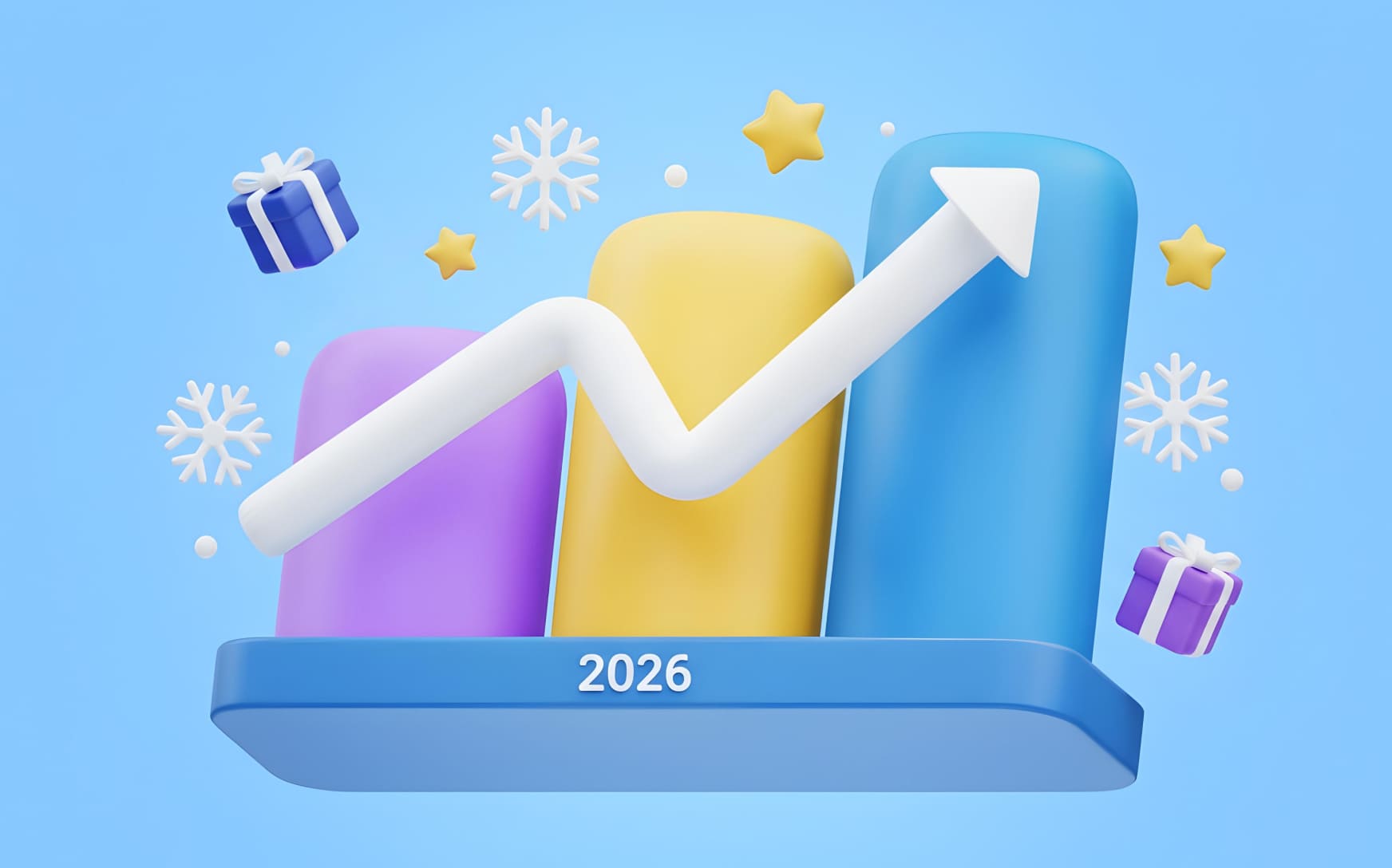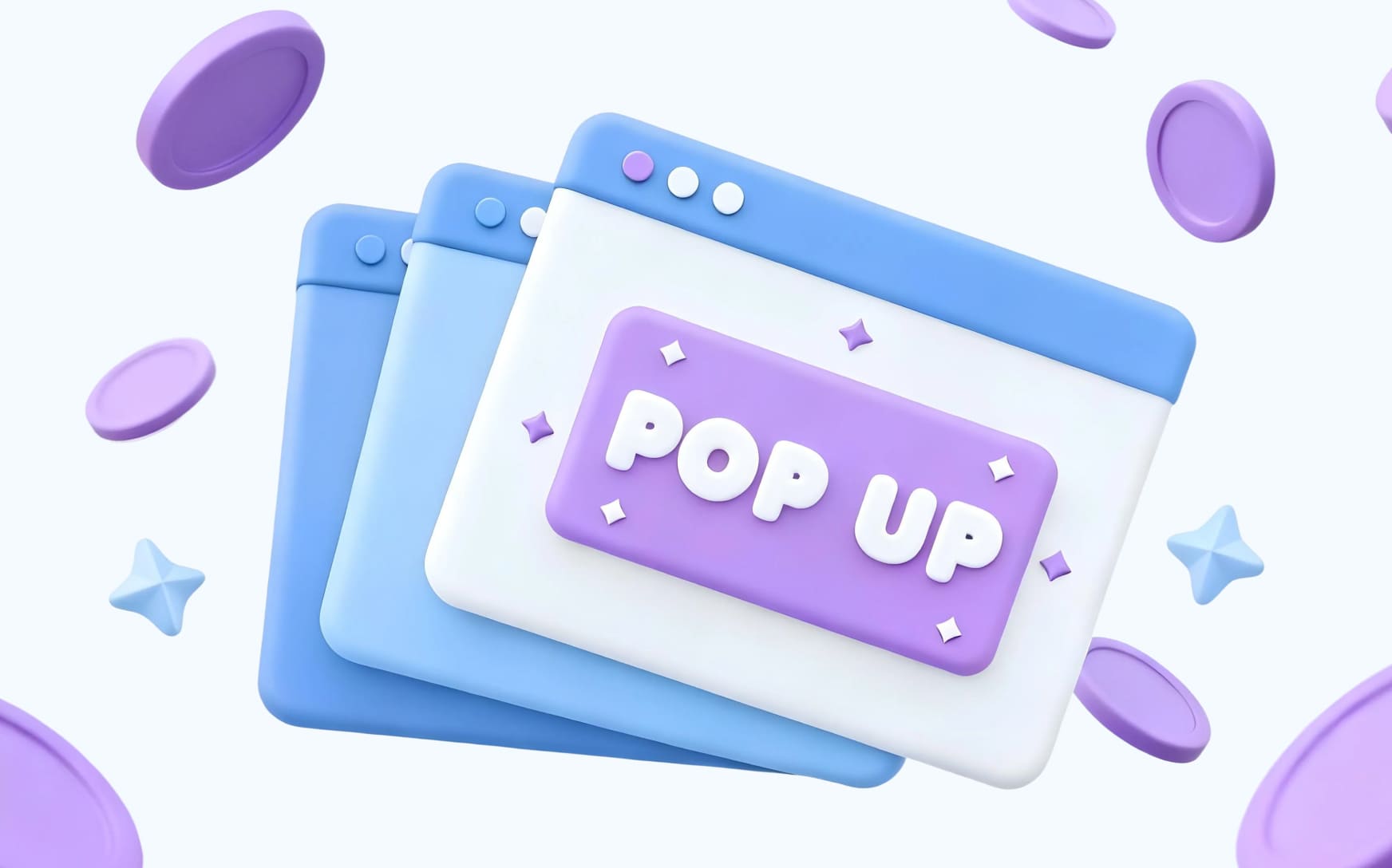Pop-up ads — also known as pops (including both pop-ups and popunders) — are a format that acts as pre-landings or landing pages themselves, designed to capture attention, generate leads and drive conversions. They perform well in gambling, betting, dating, finance, sweepstakes and software, and when paired with clear goals, tracking and mobile-first, AI-driven optimization, pops are one of the most effective ad formats for advertisers.
Pop up ads are one of the most debated formats in digital marketing. Some advertisers see them as intrusive, while others know that — when used correctly — they can deliver unmatched engagement and strong conversion rates. In 2025, popups are still a relevant tool for affiliate marketers, brands and media buyers who want to capture attention fast and generate leads at scale.
Unlike static display banners that often suffer from banner blindness, a well-timed pop up advertisement interrupts the user journey in a way that demands interaction. That’s why pop up marketing is part of high-performing campaigns across multiple verticals — from e-commerce discounts to gambling offers, finance products and subscription funnels.
In this guide, we’ll cover:

- What are pop up ads and how they work
- Pop-ups vs popunders (together often called “pops”)
- Real-world pop up ads examples and best practices
- Marketing strategies to increase CTR, leads and conversion rates
- Tips for running campaigns on ad networks and optimizing results
By the end you’ll not only know the pop up ads meaning but also how to use them effectively in your campaigns without falling into the traps of intrusive or outdated advertising.
What Are Pop Up Ads? Definition & Meaning
When people ask “what are pop up ads” the answer is simple: they are online advertisements that appear in a new browser window or tab, on top of the active content.
Pop Up Ads Definition
In digital terms, a pop up advertisement is a format that interrupts the user journey and captures attention immediately. The pop up ads meaning is tied to visibility — they pop up in front of the user and can’t be ignored.
Pop Ups vs. Popunders
Many use the term popups loosely but it’s important to define pop up and popunder ads separately.
- Pop-Up Ads: open in front of the current page, demanding instant attention.
- Popunder Ads: load under the active browser window, hidden until the user minimizes or closes their tab.
Both are called pops and are often grouped together by ad networks and affiliates.
Table: Pop-Up vs. Popunder Ads
| Feature | Pop-Up Ads | Popunder Ads |
| Visibility | Appears immediately on top | Hidden behind active window |
| User Attention | High — interrupts current activity | Medium — seen later |
| Engagement | Strong for urgent offers & CTAs | Better for long-form content, surveys |
| Best Use Cases | Discounts, lead forms, interactive ads | Gambling, betting, finance, downloads |
| Intrusiveness | Often seen as more disruptive | Less intrusive, but lower instant CTR |
Why the Difference Matters
For affiliates and media buyers, the choice between pop-ups and popunders is strategic. Popups generate fast engagement and CTR, perfect for time-sensitive campaigns like limited offers or exit-intent retargeting. Popunders provide a more subtle interaction that can improve user experience and still deliver strong conversions for the right verticals.
Pop Up Advertising in Digital Marketing
Pop up advertising has been around for over two decades, and despite native ads, push notifications and social traffic, it’s still one of the most profitable formats for affiliates and advertisers. The reason: popups show up.
Why Pop Up Advertising Still Works
- Visibility: unlike standard display banners that can get lost in the page, a pop up ad demands attention.
- Engagement: popups drive direct interaction, whether it’s a click, a form submission or a download.
- Versatility across verticals: from e-commerce discounts to gambling registrations and finance apps, pop up ads fit almost any offer.
- Fast setup: they require minimal creative effort compared to video or complex native campaigns.
Role in Campaigns
IIn affiliate and performance advertising, pop up marketing plays a key role at different stages:
- Lead gen — capturing emails or registrations instantly.
- Retargeting — exit-intent or time-delayed popups to recover lost visitors.
- Conversion optimization — special offers that appear after engagement with the website.
- Traffic monetization — publishers can monetize websites at scale by showing pop up ads to visitors.

Roya, Emotional Damage Officer & Supreme AI Arbitragist at ROIads
For marketers, pop up advertising is not just another display format — it’s a performance tool. Unlike banners or native ads that can get lost in the background, popups guarantee exposure. When you need clicks, conversions or leads fast, pops deliver volume and visibility at scale.
Why Advertisers Still Use Pop Up Ads
- Guaranteed impressions: a pop up ad opens in front of the user, bypassing banner blindness.
- Direct engagement: users must see it, which boosts CTR compared to passive display placements.
- Cost efficiency: pop traffic is generally cheaper than premium native or social ads but still delivers competitive conversion rates.
- Scalability: with billions of daily impressions across ad networks, you can scale campaigns globally with ease.
In short, pop up marketing is about high visibility, fast testing, and scalable results.
Pop Up Ad Examples by Vertical
Pop up ads are more than just annoying windows — in performance marketing they often act as pre-landers or even landing pages, warming up the user before redirecting them to the main offer. For advertisers this means a well-structured popup can filter, engage and qualify traffic before the conversion point, increasing ROI.
Here’s an overview how popups work in the leading verticals.
Gambling
- Spin-to-win mechanics: gamified wheels and prize draws keep users engaged and mimic the feeling of gambling.
- Bonus reveal popups: users are shown free spins, match bonuses or deposit multipliers before registration.
- Time pressure: countdown timers to claim a bonus increase urgency and drive deposits.

Betting
- Match highlights: popups showcasing upcoming games or odds work well to grab user attention.
- First-bet insurance: offering “risk free” entry bets through a popup funnel converts hesitant bettors.
- Geo-based targeting: ads adapt to local sports events and boost CTR and signups.
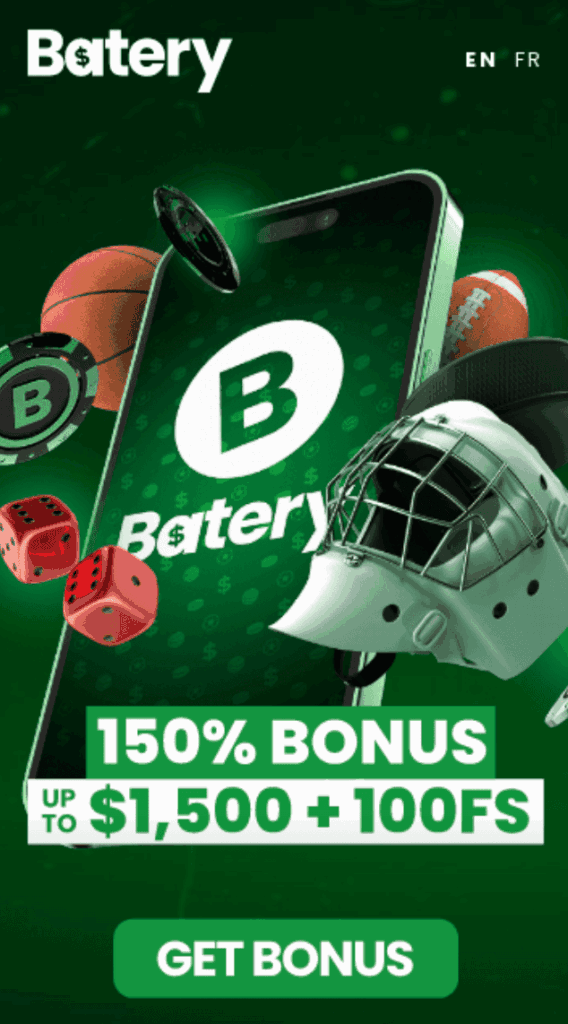
Dating
- User matching previews: pre-landers simulate profiles waiting nearby and encourage registrations.
- Step funnels: popups asking simple yes/no questions (“Are you 18+?” “Looking for women/men?”) guide the user deeper into the funnel.
- Social proof: showing “active users online now” increases trust and engagement.

Finance
- Short lead forms: simple fields (name, phone, email) in a popup generate qualified leads.
- Urgency hooks: messages like “only a few slots left today” drive users to apply.
- Educational prompts: finance popups often include benefits like “check your loan eligibility in 60 seconds”.
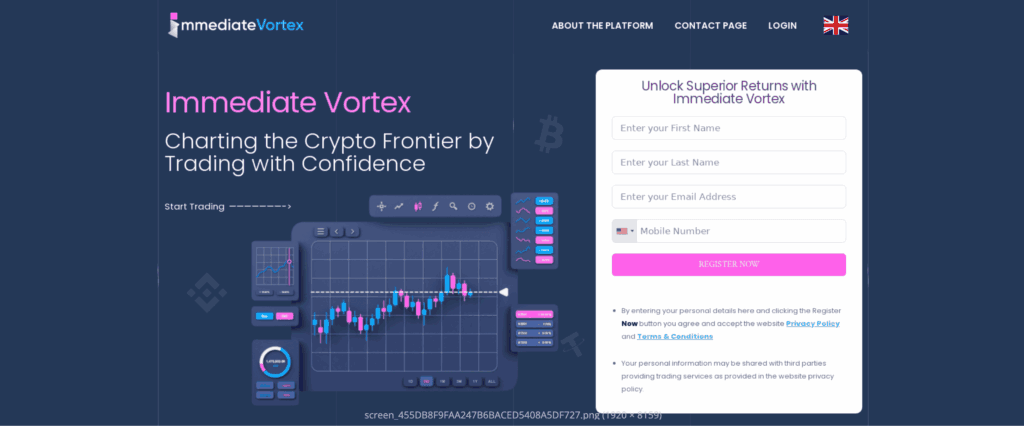
Sweepstakes
- Gift box mechanics: users “open” a present to reveal a prize or entry opportunity.
- Instant-win claims: emphasizing quick gratification motivates users to provide data.
- Exit-intent triggers: when a user tries to leave a popup offers another chance to win, reducing drop-offs.
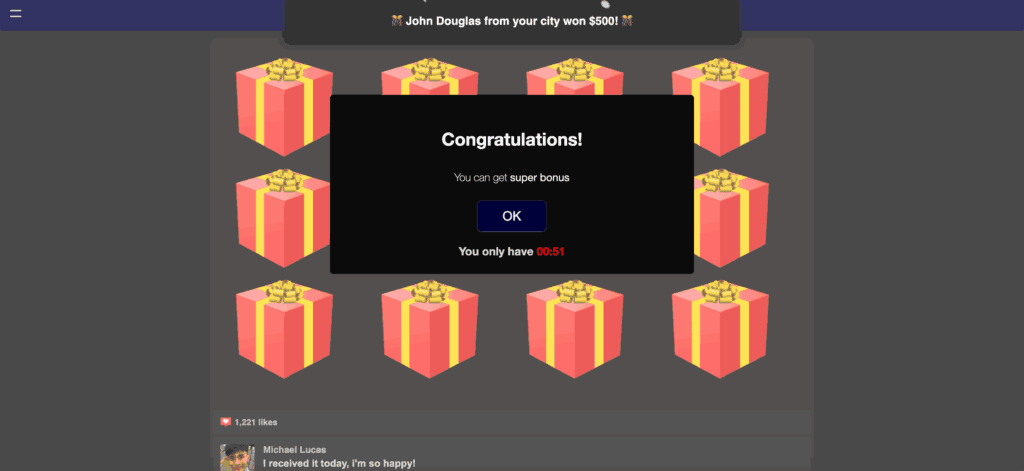
Software (Utilities & Antivirus)
- Performance alerts: popups simulate warnings (“Your PC is slow”) to nudge users to download.
- Cleaner tools: ads highlight instant solutions (optimize, speed up, remove viruses).
- Free trial offers: giving access to a basic version directly from the popup builds trust before upselling.
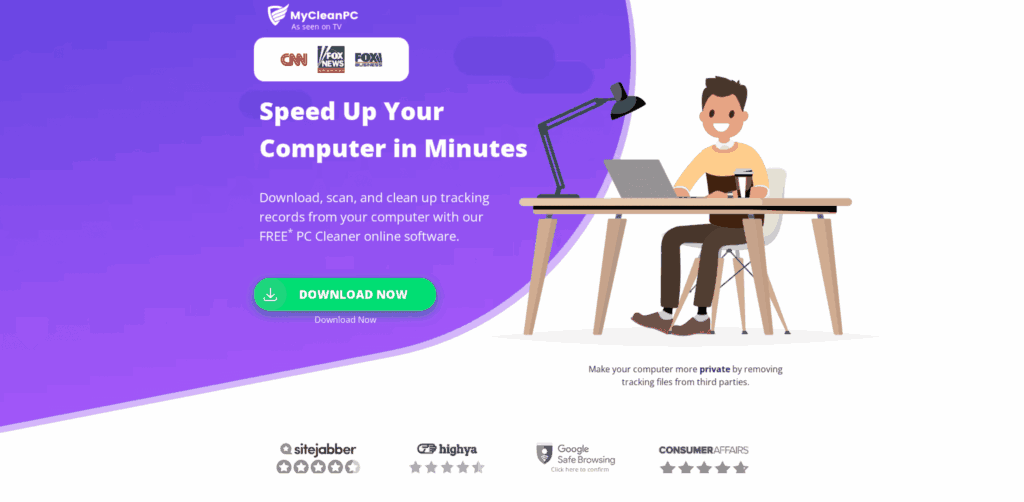
Advantages and Disadvantages of Popups for Advertisers
Like any ad format, popups have their ups and downs. For advertisers, the real value is understanding where pops deliver maximum ROI — and where to manage the risks.
Advantages of Pop Up Ads
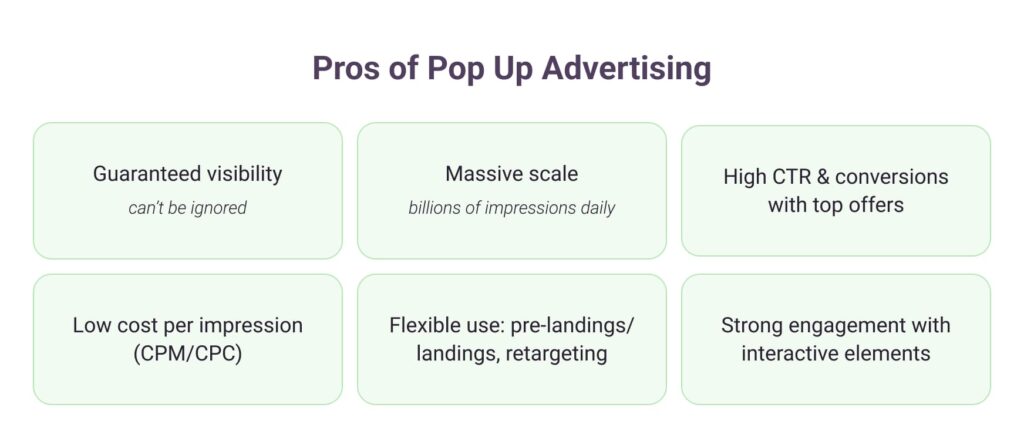
- Guaranteed visibility: unlike banners or native ads, a popup ad opens in front of the user and can’t be ignored.
- Massive scale: billions of daily impressions are available across ad networks, making pops one of the easiest formats to scale globally.
- High CTR and conversions: when paired with the right offer (gambling, dating, finance, utilities), popups outperform standard display ads.
- Low cost per impression: CPM rates for pops are cheaper than social or native, user acquisition is cost effective.
- Flexibility of use: popups can be used as pre-landers, landing pages or retargeting tools, they can be used in almost any campaign.
- Engagement potential: interactive mechanics (spin-to-win, scratch cards, countdown timers) keep users engaged long enough to drive conversions.
Disadvantages of Pop Up Ads
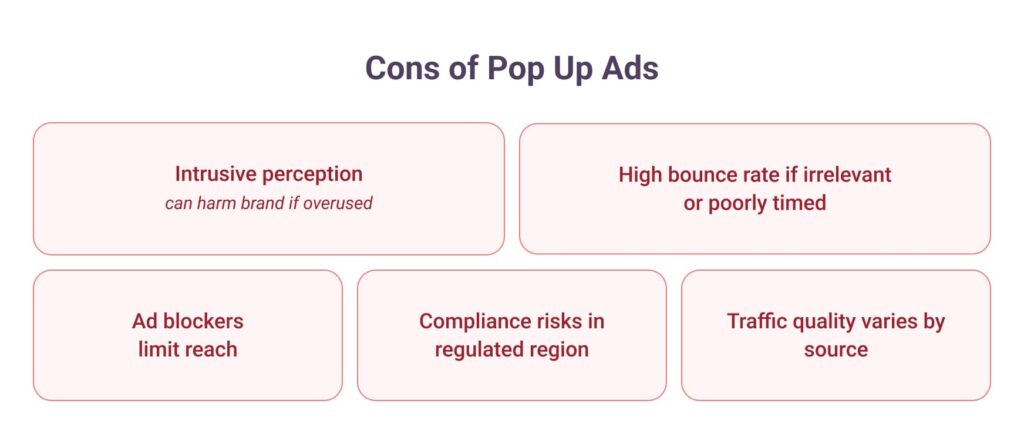
- Intrusiveness: some users find popups annoying, which can harm brand perception if overused.
- Ad blockers: a portion of desktop and mobile users use blockers, reducing reach.
- Quality variance: not all traffic sources are created equal; some networks mix in lower-quality traffic, requiring optimization and whitelisting.
- Bounce rate: if the popup is irrelevant or poorly timed, users will close it immediately, wasting impressions.
Key Takeaway for Advertisers
The best pop up ads are those that balance visibility with value. When the offer is good, time-sensitive and well-targeted, popups can outperform more expensive formats. But advertisers must also consider optimization, impressions cap, compliance and creative strategy to avoid waste.
Pop Up Marketing Strategies That Work in Ad Networks
Running pop up ads in ad networks is not just about buying traffic — it’s about structuring the funnel correctly. Here are six strategies advertisers use to improve CTR, engagement and conversion when running pops.
1. Start Broad, Then Narrow Down
Start with minimal targeting filters: just geo and device. This allows the algorithm to test a wide pool of sources. Once the campaign has enough data, you can optimize — create whitelists of profitable placements and exclude underperforming ones.
2. Combine Pops with Push
Pops deliver instant visibility, while push ads work as reminders that bring users back. Running both formats together strengthens the funnel and ensures multiple touchpoints. This works especially well in gambling and dating verticals where repeated exposure drives higher conversions.
3. Use Pops as Pre-Landers
A pop up ad can be a pre-lander, warming up the user before sending them to the main landing page. For example, countdown timers, gamification or social proof can filter traffic and increase conversion on the final offer page.
4. Retarget Users with Exit-Intent
Not everyone converts on the first visit. Retargeting through exit-intent popups can capture those about to leave and offer them a better deal or limited time bonus. This works well in betting, sweepstakes and e-commerce verticals.
5. Trust AI Bidding, Then Micro-Bid
Modern ad networks use AI to determine which pop up ads perform best. Let the algorithm test placements and adjust bids automatically, then fine tune manually with Micro bidding or source level targeting. This saves budget and accelerates scaling. For example, in ROIads ad network you can find a lot of top-tier smart features like CPA goal and AI bidding technology, created to help you launch with ease.
6. A/B Test Creatives and Funnels
No single pop up marketing flow converts everywhere. Always test variations of pre-landers, forms and triggers. Geo-specific behavior and device differences can change conversion dramatically, so continuous testing ensures your campaigns stay profitable.
Final Note for Advertisers
Pops are a great way to drive users to landing pages and pre-landers, but success depends on smart strategy: test broad, optimize efficiently and leverage technology.
❗To put these strategies into action with only premium traffic and advanced optimization tools, run your campaigns on ROIads advertising network. With access to push and pops in 150+ geos, plus features like AI bidding technology, Micro bidding, and CPA Goal, ROIads helps advertisers maximize ROI from every campaign.
How to Optimize Pop Up Campaigns
Running pop up ads campaigns without optimization is one of the fastest ways to burn your budget. Advertisers must treat pops as a performance format — analyze, test and adjust constantly. Here are the areas that should always be part of your workflow.
- Define Clear Goals: Every campaign should start with a clear objective: leads, registrations, installs or deposits. When you define pop up campaigns this way, optimization becomes easier because you can measure against a specific KPI instead of chasing clicks.
- Track Every Metric: Monitor CTR, conversion rate (CR), cost per lead (CPL) and ROI across placements. Pops deliver huge volumes but without tracking you won’t know which traffic sources are profitable and which are draining spend.
- Adjust Targeting and Sources: Use whitelists to focus on the best performing publishers and blacklists to cut underperformers. Apply Micro bidding to fine-tune bids for specific sources, devices or geos. This level of control makes a direct impact on profitability.
- Optimize Creatives and Pre-Landers: Even small changes in the pop up ad funnel can boost performance. Test different timers, form lengths or incentive structures. Geo-based adaptations (language, currency, local offers) often improve conversion significantly.
- Iterate Constantly: Successful advertisers treat optimization as an ongoing cycle. Collect data, test variations and scale what works. Pops are high volume — which means they deliver statistically significant insights faster than most other formats.
Optimization Checklist for Pop Up Ads
| Area | What to Do | Why It Matters |
| Goal Setting | Define leads, sales, or deposits as primary KPI | Keeps campaign focus on measurable outcomes |
| Tracking | Monitor CTR, CR, CPL, EPC, ROI | Identifies profitable vs. wasted spend |
| Source Optimization | Whitelist strong publishers, blacklist weak ones | Ensures budget flows into quality traffic |
| Bidding | Use AI bidding + Micro bidding adjustments | Maximizes efficiency without losing volume |
| Creatives/Pre-landers | Test variations (timers, forms, bonuses) | Improves funnel performance per geo/vertical |
| Retargeting | Implement exit-intent and repeat popups | Recovers lost users and boosts conversion rates |
| Iteration | Run continuous A/B tests and scale winners | Keeps campaigns profitable long-term |
Optimizing pops isn’t just about reducing costs — it’s about building campaigns that convert consistently. With the right balance of AI automation and manual adjustments advertisers can get predictable results.
Future of Pop Up Advertising
The perception of pop up ads has changed dramatically over the years. What once was seen as intrusive is now evolving into a more targeted, interactive, and user-friendly format. For advertisers, this evolution means new opportunities to improve CTR, engagement, and conversions without alienating users.

1. Shift Toward Native-Like Popups
Future pop up ads will look and feel like part of the website or app. By blending in with the digital environment these ads avoid banner blindness while keeping high visibility. Advertisers who go native will see better user engagement.
2. Mobile-First Development
Over 65% of global traffic is mobile. Pops that don’t adapt to small screens will lose conversions instantly. Expect mobile-first pops with responsive layout, one tap CTAs and localized language to rule in 2025 and beyond.
3. AI-Powered Personalization
Machine learning is already defining pop up strategies but the next step is hyper-personalized ads. AI will adjust content, timing and frequency per user — so each popup feels relevant not disruptive.
4. Interactive & Gamified Experiences
Static banners are being replaced by interactive popups: spin-to-win, scratch cards, mini-games. These formats create engagement loops that feel fun which increases lead capture and time-on-page. For gambling, betting and sweepstakes this is especially powerful.
5. Compliance and Transparency
Ad blockers and privacy regulations won’t go away. Advertisers need to prepare for stricter compliance rules in major markets. Networks that provide transparent stats and clear source reporting will win, while shady traffic providers will lose.
What This Means for Advertisers
The future of pop up marketing isn’t about avoiding disruption at all costs — it’s about creating value-driven, interactive and personalized experiences that users respond to. Advertisers who adapt to these changes will find pops remain one of the highest ROI ad formats available.
With ad networks like ROIads, you can already test AI bidding technology, Micro bidding and premium traffic sources to prepare for these trends today.
Conclusion
Pop up ads are one of the most reliable tools in digital marketing when used strategically. Far from being outdated they continue to drive leads, conversions and engagement across the top verticals: gambling, betting, dating, finance, sweepstakes and software. By understanding pop up ads’ meaning, advertisers can stop treating them as random interruptions and start treating them as a high-effective format that guides users directly into the funnel.
The key to success is threefold:
- Clear strategy — define pop up campaigns around specific goals, whether that’s registrations, deposits or lead gen.
- Smart optimization — track CTR, ROI and user engagement while refining traffic sources and bidding.
- Adaptation to trends — use mobile-first, interactive and AI-personalized formats to stay ahead of the competition.
Yes, popups can be intrusive if misused — but in the right hands, they are still among the best pop up ads examples of performance marketing at scale.
If you’re ready to put these insights into practice, the next step is simple: test your pop up advertising campaigns with a trusted network. At ROIads, we provide advertisers with premium push and pop traffic, advanced targeting options, and optimization features like AI Bidding, Micro Bidding, and CPA Goal. This means you can launch, optimize, and scale your pop up marketing campaigns with confidence.
FAQ: Pop-Up Ads Guide
❓What are pop-up ads?
Pop-up ads are online ads that open in a new window or tab, used in affiliate marketing as pre-landers or landing pages to generate leads and conversions.
❓Are pop-up ads still effective in 2025?
Yes, pop-up advertising is still effective in 2025 with mobile-first design, AI-driven targeting and strong performance in top verticals.
❓What is the difference between pop-up and popunder ads?
A pop-up ad appears on top of the active window, a popunder opens behind it. Together they are called “pops”.
❓Do pop-up ads work on mobile devices?
Yes, modern pop up ads are mobile-optimized with responsive layouts and one-tap CTAs to improve engagement and conversion.
❓Are pop-up ads safe for users?
Popups are safe when served through reputable ad networks that provide compliance and quality traffic, no malicious redirects.
❓How much do pop-up ads cost?
Pop-up ads run on the CPM model. Prices vary by geo, vertical and device type, but pops are generally cheaper than native or social ads, they are a cost-efficient traffic source. In ROIads, for example, the minimum CPM is $0.5 and rates for each geo and device are available in the Insights tab of your account dashboard.
